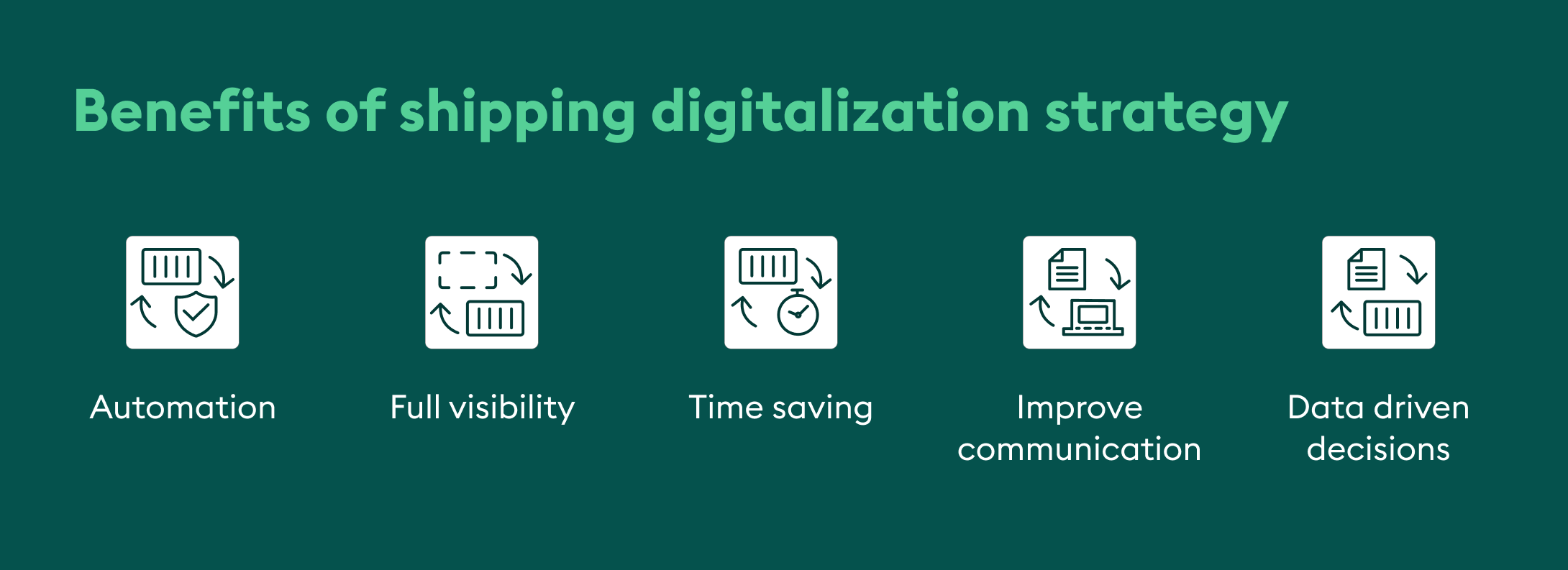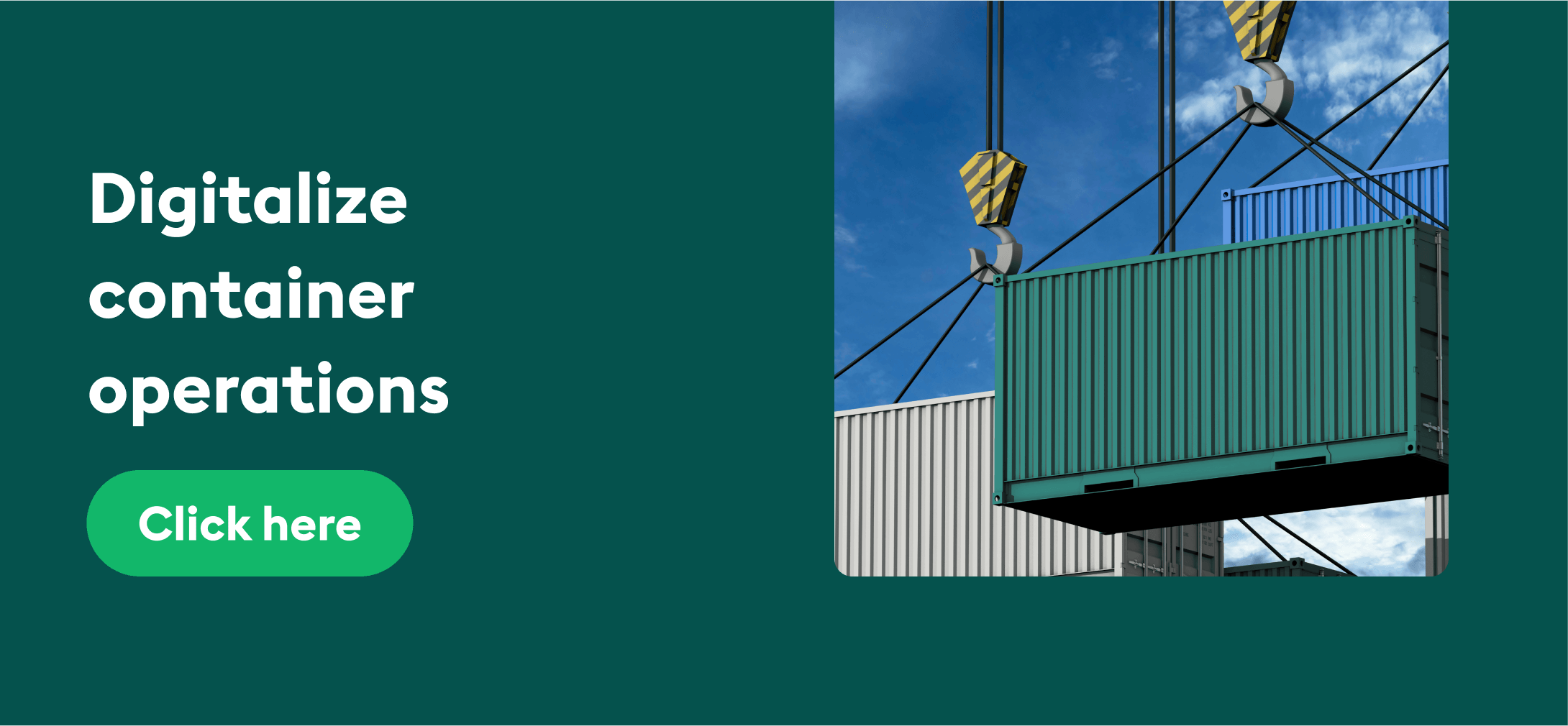Digitalization has revolutionized the shipping industry in more ways than one. From streamlining container operations to increasing the efficiency and safety of both cargo and cargo handlers, the shipping digitalization strategy has a major role to play. In this blog, we’ll uncover the benefits of the digitalization of logistics and the key factors that open up a world of possibilities for all stakeholders involved.
Many companies have adopted technology to improve their operations and commercial processes. For instance, the widespread use of mobile devices and the Internet of Things (IoT) has enabled real-time ocean container tracking and improved communication between different stakeholders in the supply chain.
However, there is still room for improvement in adopting and implementing digital technology in the logistics industry. Many small, medium, and big-sized freight forwarders in the industry are still relying on manual processes and outdated technology.
In a survey conducted by Container xChange, >80% of the freight forwarders and NVOCCs claimed they still use email and phone to get quotations and sailing schedules. And 78% of them used the same outdated processes to place a booking. This, eventually, limits their efficiency and competitiveness.
Many digital freight solutions, such as Cargofive and Container xChange, allow full visibility of ocean freight rates, container prices and leasing rates globally. Having access to such market intelligence empowers freight forwarders to improve their logistics and business proposals to their customers.
By embracing digital technologies, we, at xChange, bring you one step closer to revolutionizing your container logistics and operations from the get-go. We bring you a hassle-free and seamless experience. Click the banner below to check out the Container xChange platform in action!
Shipping digitalization strategy of ports in 2024
To meet the growing demands of the digital age, many ports have now switched to digitalization and are becoming ‘smart ports.’ A smart port integrates cutting-edge technologies and data-driven solutions to streamline maritime operations. This creates room for a more sustainable supply chain.
These smart ports rely on emerging technologies such as digital twins ( a virtual model of a physical object that’s created using smart sensors for data collection) to capture the data of a vessel and monitor it in real-time. It also continuously updates the vessel information with new ways to enhance its performance. So, you can troubleshoot operations and predetermine the future performance of your vessel.
The aim of integrating these technologies is to enhance overall efficiency within ports, and the industry as a whole, through factors such as automated vessel management, smart berth management, and port community systems (PCS). The table below explains this in detail:
| Automated vessel management | Digitalization enables the monitoring of vessel movements, optimizing routes, and improving berth scheduling to minimize waiting times and maximize port capacity. |
| Smart beth management | Utilizing sensors and IoT devices, smart berth management systems can efficiently allocate berths to incoming vessels, reducing congestion and ensuring timely docking. |
| Port community systems | PCS platforms facilitate seamless information exchange. This integration reduces paperwork, streamlines customs processes, and expedites cargo clearance. |
These digital freight solutions have shifted shipping digitalization strategy into gear and are some of the main drivers who play a vital role in the upkeep of this new era. Apart from this, there are some key factors that also contribute to a more innovative industry:
4 key factors that drive shipping digitalization strategy
Technological advancements are reshaping the way goods are transported and managed, below are 4 key factors that drive shipping digitalization strategy today:
The Internet of Things (IoT)
The Internet of Things (IoT) has emerged as a game-changer in the shipping industry. By connecting physical devices, containers, and vessels through sensors and networks, IoT enables real-time tracking and monitoring of shipments. This technology provides valuable data on container conditions, location, temperature, and more.
e-BoL
Traditionally, the Bill of Lading (BoL) was predominantly a paper-based document essential for documenting the transfer of goods. However, with the advent of the electronic Bill of Lading (e-BoL), the shipping industry is experiencing a significant shift towards digitalization. The e-BoL offers secure and tamper-proof digital documentation. It reduces administrative burdens, eliminates manual errors, and accelerates the entire documentation process.
Tracking and API
Tracking and API integration have revolutionized shipment visibility and customer experience. With advanced tracking technologies like GPS and RFID, shippers can precisely monitor the location, movement, and status of containers in real-time. Plus, integrating tracking data through APIs allows for efficient information exchange between shipping companies, freight forwarders, and customers. This integration enables improved logistics operations and customer satisfaction.
Artificial Intelligence (AI)
You may have heard of Artificial Intelligence and how it has taken the world by storm, but did you know that (AI) is also reshaping the shipping industry? AI-powered algorithms and machine learning models analyze vast amounts of data to optimize container allocation, predict demand patterns, and streamline supply chain operations. This enhances risk management by identifying potential disruptions and offering proactive mitigation strategies.
It’s time to adapt and integrate these digital solutions into your daily container operations. Choose a smart way to reduce manual workload, human error and save time, resource, energy and lots of money for your business. Container xChange can help you make this transition seamless. Reach out to our team of experts and see our carefully curated digital platform in action.
Now, let’s take a look at how shipping digitalization can benefit you and your business:
Benefits of shipping digitalization strategy
⚡Automate manual processes
By automating manual processes like full visualization of ocean freight and container leasing and buying rates, shipment booking, invoicing, and document management, freight forwarders can save time and reduce errors.
⚡See real-time container location
Digital solutions such as Container xChange and Project44 provide real-time visibility of shipments, allowing freight forwarders to track and monitor the movements of shipping containers and keep customers updated.
⚡Real-time chat platform to improve communication
Digital solutions can improve communication and relationship between freight forwarders, carriers, and customers. By leveraging real-time chat functions in a single platform and reducing the number of emails and phone calls, forwarders can position themselves as reliable service providers in the industry.
⚡Utilize data to make data-driven decision
Freight forwarders can use digital solutions to analyze freight and container pricing and shipping data and generate reports to help them make informed decisions. This will empower freight forwarders to make more profit-driven choices and improve their overall performance.
⚡Use a marketplace to increase efficiency
By streamlining their operations with digital solutions, freight forwarders can improve their overall efficiency and reduce costs, leading to increased profitability.
⚡Technology advancements
Blockchain shipping and the development of new technologies allow freight forwarders to find suitable solutions for their commercial and logistical processes. For instance, nowadays, it’s more likely for freight forwarders to use spot rates. And they can now instantly access real-time and reliable quotations via Cargofive and Container xChange.

Streamline your freight forwarding business with our digital solutions
Imagine you’re the owner of a shipping company called ‘Fast Freight Movements’. Lately, you’ve observed the rapid pace of digitalization reshape various sectors, and you’re contemplating whether to embrace it within your own operations or not. Let’s say you decide to stick to the conventional way of doing things because you’re familiar with the way it works or simply because it’s easier for you.
Here are a few challenges you can expect to face:
Communication challenges – Your clients expect real-time data about their shipment, but you’re unable to provide them with the data right away. This is because you’ve yet to implement digital tracking systems which update you about shipments in near real-time.
Increased manual labor – You have everything manually recorded, from receipts for each shipment to client information. This is time-consuming and has a high possibility of human error. It also causes delays in documentation verification, and potential disputes with customers.
Limited supply chain visibility – The lack of supply chain visibility hinders your ability to optimize routes, plan resources effectively, and respond swiftly to changing customer demands. Automated systems provide you with the relevant information you need and streamlines your business operations.
Inefficiencies in port operations – Opting out of digitalization would mean missing out on the benefits of advanced technologies and smart port infrastructure.
However, these issues can easily be avoided with Container xChange’s digital solutions:
A one-stop online solution
Our platform leverages cutting-edge technologies to revolutionize operations, enhance safety, and propel the industry into a new era. We have been at the forefront of digital transformation within the shipping and logistics sector. Our shipping digitalization strategy revolves around:
- A complete online platform where you can manage all your container logistics and operations under one roof.
- Data-driven price insights that enable our customers to make informed business decisions.
- A collaborative ecosystem where shipping lines, container owners, freight forwarders, and other stakeholders can seamlessly connect and collaborate.
- Real-time tracking and monitoring from anywhere and at any time.
At xChange, we recognize the need for digital transformation to enhance efficiency and stay ahead in a rapidly evolving market. No need to hop from website to website or spend hours between emails and calls. Container xChange is dedicated to simplifying the process for you as much as possible. That’s why we have a global network of 1500+ members expanding over 2500+ locations. So, wherever you are, we can help you. Simply click on the banner below to speak to one of our friendly experts and get a free demo today!
Shipping digitalization strategy: Common FAQs
What is shipping digitalization strategy?
Shipping digitalization strategy refers to the process of implementing digital technologies and solutions within the shipping industry to streamline operations, enhance efficiency, and improve customer experience.
Why is shipping digitalization important?
Shipping digitalization offers numerous benefits to the industry. It improves operational efficiency by reducing manual tasks and streamlining processes. It enhances visibility and transparency throughout the supply chain, enabling better tracking and tracing of shipments.
How can shipping digitalization improve operational efficiency?
Shipping digitalization can enhance operational efficiency in several ways. Automation of manual processes reduces human error and speeds up operations. Real-time tracking and monitoring systems enable better visibility into the supply chain, reducing delays and improving planning.





